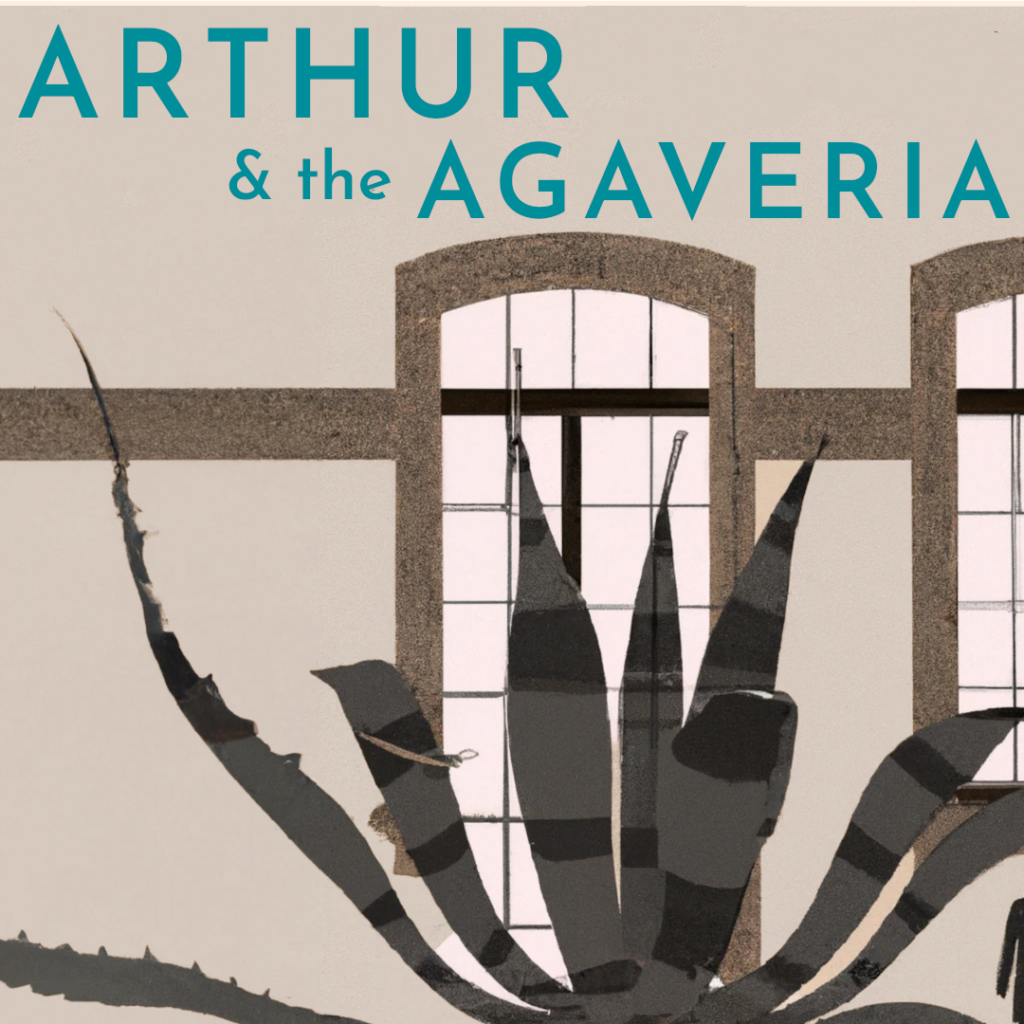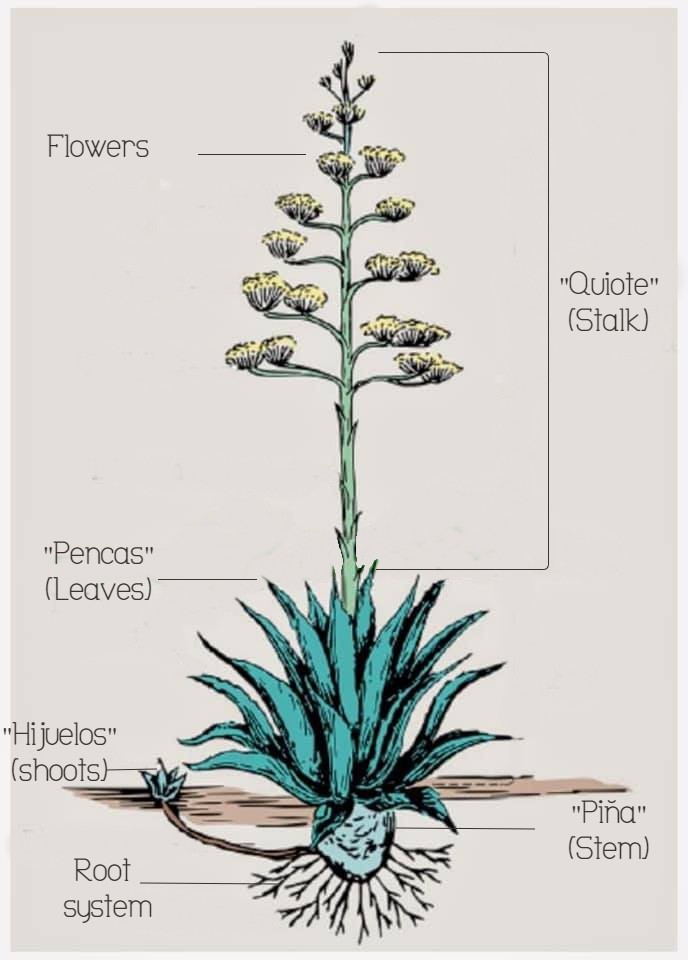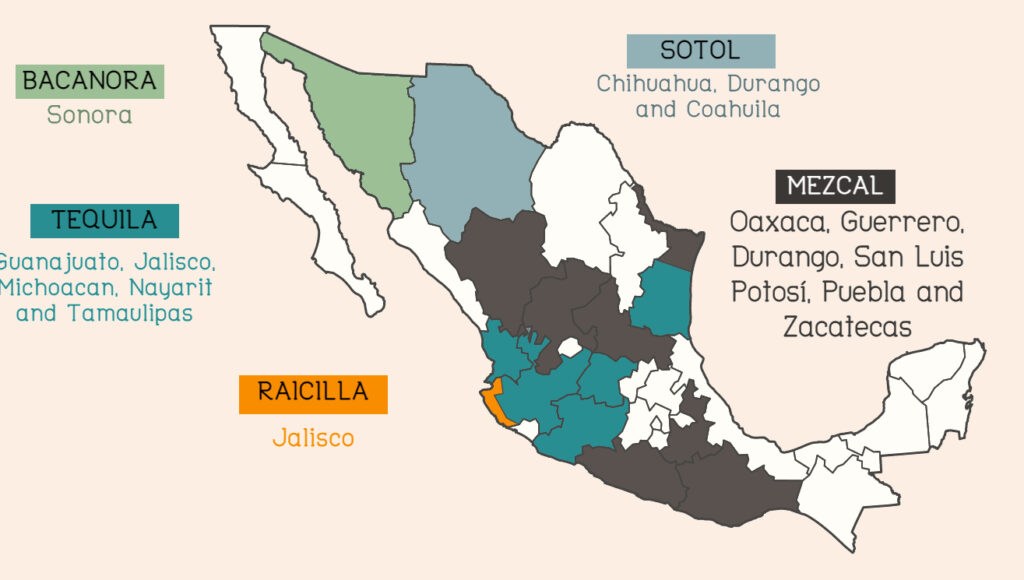“What a long day… I think I deserve a drink” I thought. So I hit the first decent cocktail bar I saw and ordered a Margarita. I wasn’t really paying attention but after my first sip, I noticed there was a Golden Ticket under the cocktail. The bartender explained to me that it means I won a free tour of The Agaveria where they will explain to me everything about Agave. And here I am, exploring the aisle of this amazing place and discovering everything about Agave. We were a small group and we were following Arthur, our guide, through the Agaveria.
We walked to a room full of different agave.

What's Agave ?
Arthur explains what was in the room and I try to put together in my mind what he’s saying and what I could read here and there in the room
Agave is a type of succulent plant in the Asparagaceae family. So it is not a cactus or an aloe vera but a cousin of the asparagus (the stalk is actually quite similar). The genus is native to the hot and arid regions of Mexico and the southern United States. They have adapted in such a way that they can store water, either in their leaves, stems or roots, making them resistant to their local climate.
Common names include agave, century plant, and maguey. Agave means “Noble”or “Admirable” in Greek.
Parts of an agave

Flowers : Agave flowers are edible and are produced by the plant towards the end of its lifetime, which can be as long as 25 years for some species. The plant blooms just once and can produce several pounds of flowers during its final growing season.
Quiote or stalk : Agave stalks, also known as quiotes, can be quite heavy and vary in size depending on the species. They are the source of aguamiel, or honey water, which is used in a similar way to sugarcane. The size of the stalks can range depending on the species of agave plant.
Pencas or leaves : Agave leaves are either short and broad or narrow and long and are arranged in rosettes that can be a few inches wide and up to 12 feet in diameter. The leaves of the agave plant produce both sap and fiber. The shape and size of the leaves can vary depending on the species of agave.
Hijuelos or shoots : are the baby agave shoots, or “pups” that grow into new plants.
Piña or stem : Heart of the agave plant is essential for the production of agave spirits. It can vary in size and can even weigh up to 1000 pounds when fully matured. The piña accumulates sugar and starch as the agave plant grows older. It is typically prepared by steaming, roasting, or smoking, and is the main ingredient in agave spirits.
Root system : The agave plant has a shallow root system and reproduces through the growth of suckers, which allow it to form colonies.
Life cycle of an agave
The age of the agave starts when the hijuelito (plant shoot) is planted on its own even though it has been existed for one or two years (Aging statement on agave spirit bottles are taking that in consideration, a bottle that says 8 years agave means that they start to plant it probably 9 or 10 years ago). Some fields have taken 3 years to harvest because each individual agave reaches maturity at different times.
Agaves are really strange plants because they reproduce in three ways (need to do some research) , none of them exclusive. They sprout little clones of themselves from their bases; these are most commonly called hijuelos and can be produced throughout an agave’s lifecycle
At the end of their lives agave plants grow a huge flower out of the center of the plant known as quiotes. The quiotes are majestic sights which soar into the air, usually 20-some feet, and display amazing yellow flowers
Type of agave
There are over 200 varieties of agave, ranging from small plants to large shrubs and trees
The next room was quite small but full of different items, apparently all made with agave
In his book Tequila Ambassador, Tomas Estes reported that in 1615, a Spanish priest and naturalist, Friar Fransisco Ximenez said “The plant alone would be sufficient to provide all things necessary for human life”, “the leaves serve as tiles to defend the roofs from the rains, the stalks serve as beams, and fibres for string are taken from the same leaves. From this they make sandals and canvas and other rope work for sacks and other things that we tend to make like linen and cotton. Nails and tacks are made from the tips of the leaves and used by the Indian to perforate their ears and flagellate themselves when they worship their gods. They also make pins, needles and arrow tips for war as well as razors for their cloth and in addition to all this, when they cut off the sprouts, cutting them with stone knives [they get] a quantity of juice or liquor from which they make wine, vinegar, honey, sugar, because by distilling this product and cooking it becomes sweeter and thicker until it finally thickens and becomes sugar. The wine is made from the same liquor, rinsing it with water and adding orange and melon rings, and other things that easily get one drunk, which is what these people most desire. From this same liquor they make vinegar, washing it in water and letting it sit in the sun for nine days. The same juice provokes menstruation in women, softens the belly, moves the urine, purifies the kidneys and the bladder, breaks the stones, cleans the urinary tract, can be used to treat wounds,etc..
We enter in what seems to be a small distillery
Agave Spirits
Agave spirit making is a process that involves several steps and can vary slightly depending on the specific type of agave spirit being produced. Here is a general overview of the process:
Harvesting : Agave plants are harvested when they are mature, which can take anywhere from 6 to 30 years depending on the species. The leaves of the plant, called pencas, are removed to reveal the piña, or heart, of the agave. The piñas are then harvested and transported to the distillery.
Cooking : The piñas are then cooked to soften the fibers and convert the starch into fermentable sugars. This can be done through a variety of methods depending on the agave spirits : for tequila, the pinas are steamed, for mezcal the pinas are roasted in an earth oven.
Milling : After cooking, the piñas are milled to extract the juice. This can be done by hand with a tool called a Tahona, or mechanically with a crusher or shredder.
Fermentation : The extracted juice, called Mosto (wurt), is then fermented to convert the sugars into alcohol. This process can take anywhere from a few days to a few weeks, depending on the desired level of alcohol and the specific recipe being used.
Distillation : After fermentation, the fermented liquid, called wash, is distilled to increase the alcohol content and remove impurities. This can be done through a variety of methods, including pot stills or column stills.
Aging : Some agave spirits, such as tequila, can be aged in oak barrels to add depth of flavor and smoothness. The length of aging can vary from a few months to several years.
Bottling : Once the spirit has been distilled and aged, if applicable, it is bottled and labelled for distribution.
States
Think of agave spirits like different types of wine. Just as there’s a big category called “wine” with variations like Rioja and Champagne, Mexico’s agave spirits range from from places like Oaxaca in South to Sonora up North. Each regions males its own unique drink based on the local agaves and process.
Mexican agave spirits have special rules depending on where they’re from.

Mezcal
A sign says :
Para todo mal, mezcal, y para todo bien, también
The Aztecs appreciated a fermented beverage called pulque, which used the sap of the agave plant (this technique may have been used by the Olmecs, an even older civilization based in the lowlands of Mexico, dating back to 1000 BC). The liquid was so important to the Aztec culture that they worshipped two gods known for their association with alcohol. The first was Mayael, the goddess of Maguey, and the second was her husband Patecatl, the goddess of Pulque. The drink really caught on centuries later when the Aztecs received a surprise visit from the Spanish. There are several theories as to when agave distillation began, but the common story relates to the Spanish invasion and primitive mud distillers. The Spanish could not live without brandy for a long time. When supplies ran low, they improvised with mud and pulque, essentially creating what we know today as mezcal.
Mezcal must be cooked in before they are distilled. Traditionally, this is done by burying the plants in a pit oven with hot rocks, but other methods are also allowed.
The word mezcal comes from Nahuatl mexcalli [meʃˈkalːi], which means “oven-cooked agave”. The fermented agave juice (called Mosto) must be distilled in copper or clay pot stills.
Mezcal must be bottle in Mexico and come from 6 different states :
-
-
- Oaxaca
- Durango
- Puebla
- San Luis Potosi
- Guerrero
- Zacateca
-
Tequila
A sign says :
The maguey is the most precious gift that nature has given to Mexico, Tequila gives his name to the brandy of Mezcal, just like Cognac gives it to the brandies of France in general.
The Spanish explorer Hernán Cortés discovered the area that is now known as Jalisco in Mexico. He encountered a tribe called the Tequili who lived in a village named Tequitilan, meaning “land of hard work.” He shorten the name to “Tequila”.
In an attempt to take ownership of the term “Tequila,” the Mexican government declared intellectual property rights to the term in 1974
This also made it illegal for other countries to manufacture or sell their own “Tequila”, requiring that tequila be manufactured and aged in certain areas of Mexico. There are several rules around the Tequila production such as :
-
- Tequila must come from 5 different states :
-
- Guanajuato
- Jalisco
- Michoacan
- Nayarit
- Tamaulipas
-
- It must be produced with 100% Blue Weber agave
- It must be cooked in a steam oven and must be distilled twice
- Must be bottled in Mexico
- Tequila must come from 5 different states :
There are several different types of tequila, which are classified based on their aging process and the percentage of agave used in the production.
Blanco (also known as Silver or Plata): This type of tequila is clear and unaged, and it is bottled immediately after distillation. It is generally considered to have a crisp, fresh, and herbaceous flavor, with notes of citrus and pepper.
Reposado: tequila is aged for a minimum of two months and up to a year in oak barrels. This type of tequila is often light golden in color, and it has a more complex flavour profile than blanco tequila, with notes of vanilla, caramel, and oak.
Añejo: tequila is aged for a minimum of one year and up to three years in oak barrels. This type of tequila is darker in color than reposado, and it has a more intense and complex flavor, with notes of chocolate, tobacco, and smoke.
Extra Añejo: tequila is aged for a minimum of three years in oak barrels. This type of tequila is the darkest and most complex of all the types, with a rich and intense flavour that is often compared to that of a fine cognac.
Cristalino : It is a relatively new type of tequila that has gained popularity in recent years. It is essentially a clear añejo tequila, meaning that it is aged for at least a year in oak barrels, and then filtered to remove the colour and any impurities, resulting in a clear, transparent liquid. The filtration process used to create cristalino tequila can vary, but it often involves a combination of charcoal and micron filters. This results in a tequila that has the complex flavours and aromas of an aged tequila, but without the darker color that is usually associated with it.
Cristalino tequila is often described as having a smooth, silky texture, with notes of caramel, vanilla, and oak
It’s worth noting that tequila can also be classified as 100% agave tequila or mixto tequila. 100% agave tequila is made entirely from the blue agave plant, while mixto tequila is made with at least 51% agave, and the remaining portion is usually made up of other sugars, such as cane sugar or corn syrup.
Bacanora
A sign says :
“Bacanora, el alma de Sonora,”
It has the same production process as Mezcal (roasted in earthen pits for days, ground to a pulp, then fermented and distilled). Just like Tequila, Bacanora has to be produced in a certain place , it has a denomination of origin tied to the state of Sonora, and with a specific breed of agave called Agave Pacifica (Angustifolia Haw).
Bacanora appeared in the north of Mexico in the late 19th century but got banned from production by the constitutionalist governor of Sonora, Plutarco Elias Calles. He actually banned the sale and manufacturing of any intoxicating beverages due to his moralistic views of alcohol. In 1919, when the ban on hard liquor got lifted, no new regulations were put in place, the liquor stayed underground. It would be produced and sold illegally for years to come due to its criminal association.
It wasn’t until 1992 that the Mexican government acknowledged its production and commercialization. In 2000, bacanora was finally granted a denomination of origin in its home state of Sonora.
Sotol
A sign says :
Sotol gives you what it feeds on
Sotol has pretty much the same historical background as Bacanora, the production was banned for most of the 20th century and it’s only from the early 90’s that the laws were lifted and Sotol unbanned.
Sotol also has a denomination of origin and can only be produced in three states in the North of Mexico : Chihuahua, Coahuila, Durango.
The main difference with a mezcal (the production steps remaining the same) is the plant that it is made of. Sotol is made from Dasylirion Wheeleri, a desert spoon and takes its name from the Nahuatl word ‘Tzotolin’, which means ‘palm with long and thin leaves’. This plant is actually not an agave anymore since its taxonomy changed in the 90s, but it is still from the same Asparagaceae family.
However, Sotol is still widely considered as an agave spirit since the Desert Spoon has similarities with an agave in its behaviour, growth and looks. There are 15 different species of Dasylirion and 5 varieties so terroir is really important and has a huge impact on the spirit’s flavour.
Raicilla
A sign says :
“Grounded in the Earth”
It’s typically produced in the regions around the Mexican state of Jalisco, particularly in the Sierra Madre mountains. Raicilla can’t be called Tequila because it’s made using other agave species like Angustifolia or Maximiliana can’t be called Mezcal either has it’s produce outside of the denominated states. The taste can vary depending on the specific agave species used and the production methods employed by different producers, resulting in a range of flavors from fruity and floral to earthy or smoky.
The name “raicilla” originated from local producers who used it to avoid paying taxes that was normally asked when producing Mezcal. They claimed their spirit didn’t come from the heart of the agave (piña) like mezcal, but rather from the “Little Roots” (Raicilla).

